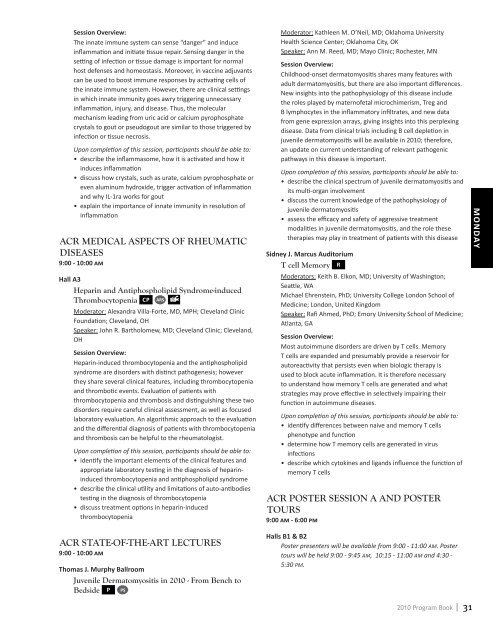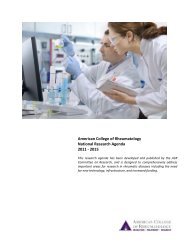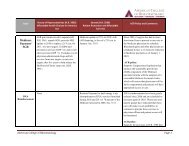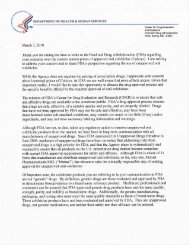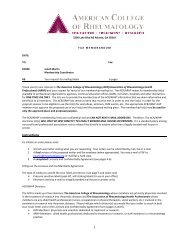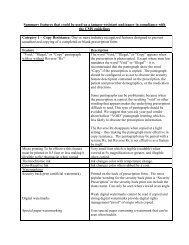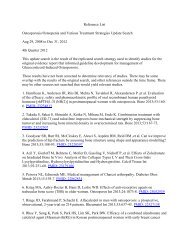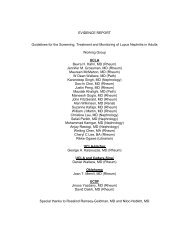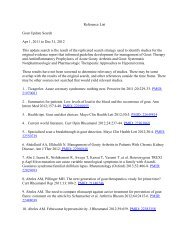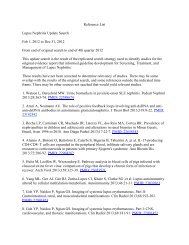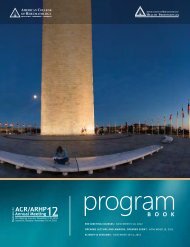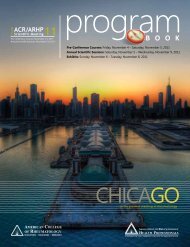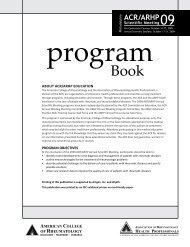B O O K - American College of Rheumatology
B O O K - American College of Rheumatology
B O O K - American College of Rheumatology
Create successful ePaper yourself
Turn your PDF publications into a flip-book with our unique Google optimized e-Paper software.
Session Overview:<br />
The innate immune system can sense “danger” and induce<br />
inflammation and initiate tissue repair. Sensing danger in the<br />
setting <strong>of</strong> infection or tissue damage is important for normal<br />
host defenses and homeostasis. Moreover, in vaccine adjuvants<br />
can be used to boost immune responses by activating cells <strong>of</strong><br />
the innate immune system. However, there are clinical settings<br />
in which innate immunity goes awry triggering unnecessary<br />
inflammation, injury, and disease. Thus, the molecular<br />
mechanism leading from uric acid or calcium pyrophosphate<br />
crystals to gout or pseudogout are similar to those triggered by<br />
infection or tissue necrosis.<br />
Upon completion <strong>of</strong> this session, participants should be able to:<br />
• describe the inflammasome, how it is activated and how it<br />
induces inflammation<br />
• discuss how crystals, such as urate, calcium pyrophosphate or<br />
even aluminum hydroxide, trigger activation <strong>of</strong> inflammation<br />
and why IL-1ra works for gout<br />
• explain the importance <strong>of</strong> innate immunity in resolution <strong>of</strong><br />
inflammation<br />
ACR Medical Aspects <strong>of</strong> Rheumatic<br />
Diseases<br />
9:00 - 10:00 am<br />
Hall A3<br />
Heparin and Antiphospholipid Syndrome-induced<br />
Thrombocytopenia cP ARS<br />
Moderator: Alexandra Villa-Forte, MD, MPH; Cleveland Clinic<br />
Foundation; Cleveland, OH<br />
Speaker: John R. Bartholomew, MD; Cleveland Clinic; Cleveland,<br />
OH<br />
Session Overview:<br />
Heparin-induced thrombocytopenia and the antiphospholipid<br />
syndrome are disorders with distinct pathogenesis; however<br />
they share several clinical features, including thrombocytopenia<br />
and thrombotic events. Evaluation <strong>of</strong> patients with<br />
thrombocytopenia and thrombosis and distinguishing these two<br />
disorders require careful clinical assessment, as well as focused<br />
laboratory evaluation. An algorithmic approach to the evaluation<br />
and the differential diagnosis <strong>of</strong> patients with thrombocytopenia<br />
and thrombosis can be helpful to the rheumatologist.<br />
Upon completion <strong>of</strong> this session, participants should be able to:<br />
• identify the important elements <strong>of</strong> the clinical features and<br />
appropriate laboratory testing in the diagnosis <strong>of</strong> heparininduced<br />
thrombocytopenia and antiphospholipid syndrome<br />
• describe the clinical utility and limitations <strong>of</strong> auto-antibodies<br />
testing in the diagnosis <strong>of</strong> thrombocytopenia<br />
• discuss treatment options in heparin-induced<br />
thrombocytopenia<br />
Moderator: Kathleen M. O’Neil, MD; Oklahoma University<br />
Health Science Center; Oklahoma City, OK<br />
Speaker: Ann M. Reed, MD; Mayo Clinic; Rochester, MN<br />
Session Overview:<br />
Childhood-onset dermatomyositis shares many features with<br />
adult dermatomyositis, but there are also important differences.<br />
New insights into the pathophysiology <strong>of</strong> this disease include<br />
the roles played by matern<strong>of</strong>etal microchimerism, Treg and<br />
B lymphocytes in the inflammatory infiltrates, and new data<br />
from gene expression arrays, giving insights into this perplexing<br />
disease. Data from clinical trials including B cell depletion in<br />
juvenile dermatomyositis will be available in 2010; therefore,<br />
an update on current understanding <strong>of</strong> relevant pathogenic<br />
pathways in this disease is important.<br />
Upon completion <strong>of</strong> this session, participants should be able to:<br />
• describe the clinical spectrum <strong>of</strong> juvenile dermatomyositis and<br />
its multi-organ involvement<br />
• discuss the current knowledge <strong>of</strong> the pathophysiology <strong>of</strong><br />
juvenile dermatomyositis<br />
• assess the efficacy and safety <strong>of</strong> aggressive treatment<br />
modalities in juvenile dermatomyositis, and the role these<br />
therapies may play in treatment <strong>of</strong> patients with this disease<br />
Sidney J. Marcus Auditorium<br />
T cell Memory R<br />
Moderators: Keith B. Elkon, MD; University <strong>of</strong> Washington;<br />
Seattle, WA<br />
Michael Ehrenstein, PhD; University <strong>College</strong> London School <strong>of</strong><br />
Medicine; London, United Kingdom<br />
Speaker: Rafi Ahmed, PhD; Emory University School <strong>of</strong> Medicine;<br />
Atlanta, GA<br />
Session Overview:<br />
Most autoimmune disorders are driven by T cells. Memory<br />
T cells are expanded and presumably provide a reservoir for<br />
autoreactivity that persists even when biologic therapy is<br />
used to block acute inflammation. It is therefore necessary<br />
to understand how memory T cells are generated and what<br />
strategies may prove effective in selectively impairing their<br />
function in autoimmune diseases.<br />
Upon completion <strong>of</strong> this session, participants should be able to:<br />
• identify differences between naive and memory T cells<br />
phenotype and function<br />
• determine how T memory cells are generated in virus<br />
infections<br />
• describe which cytokines and ligands influence the function <strong>of</strong><br />
memory T cells<br />
ACR Poster Session A and Poster<br />
Tours<br />
9:00 am - 6:00 pm<br />
monday<br />
ACR State-<strong>of</strong>-the-Art Lectures<br />
9:00 - 10:00 am<br />
Thomas J. Murphy Ballroom<br />
Juvenile Dermatomyositis in 2010 - From Bench to<br />
Bedside P PS<br />
Halls B1 & B2<br />
Poster presenters will be available from 9:00 - 11:00 AM. Poster<br />
tours will be held 9:00 - 9:45 AM, 10:15 - 11:00 AM and 4:30 -<br />
5:30 PM.<br />
2010 Program Book 31


